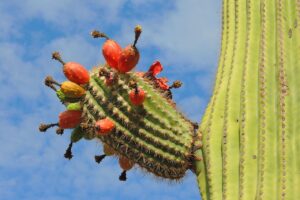In the verdant kingdom of cacti, two intriguing specimens rise to prominence: the Monkey Tail Cactus and the Donkey Tail Cactus. Each possesses its own idiosyncratic charm and allure, drawing collectors and horticultural enthusiasts alike into their spiny embrace. While they may share a family resemblance, embarking on a closer examination reveals a stunning dichotomy rooted in their structure, care needs, and overall aesthetic appeal.
As we journey through their distinctive pathways, we shall unearth the nuances that set these two leafy wonders apart. Prepare to explore their unique attributes, captivating care tips, and the enchanting qualities that elevate these cacti beyond mere plants into veritable companions for the eye and soul.
Emphasizing the Adornments: A Textural Contrast
The visual allure of the Monkey Tail Cactus, formally known as Cleistocactus colademononis, cannot be overstated. Its most striking feature is its long, trailing stems adorned with elongated spines, reminiscent of thick, cascading hair. This striking morphology invites an enchanting metaphor: the Monkey Tail Cactus often acts as nature’s own version of a flamboyant artist, draping its appendages in eccentricity with a confidence that mirrors a peacock fanning its tail. This distinctive form has garnered it a reputation as an attention magnet, captivating observers with its lush, almost whimsical appearance.
In contrast, the Donkey Tail Cactus, or Sedum morganianum, presents a more demure yet equally intriguing visage. Its plump, elongated leaves—often dubbed “tails”—hang delicately from the plant, creating the image of a graceful creature meandering through a sunlit garden. While the Monkey Tail Cactus flaunts its unrestrained exuberance, the Donkey Tail exudes a sense of quiet tranquility, akin to a wise elder casually relaying tales of the past. Together, they illustrate the duality present in nature, where exuberance meets serenity.
Navigating Their Habitat Needs: Shady Lairs vs. Sun-Kissed Terrains
Understanding the preferred habitats of these two cacti is paramount for ensuring their well-being and cultural success. The Monkey Tail Cactus hails from the arid, elevated regions of South America where it thrives under direct sunlight. This creature of habit requires a minimum of six hours of bright light daily to flourish, calling for an adequately lit windowsill or a greenhouse. It relishes warm temperatures and benefits from a dry environment, thriving best amid conditions that mimic its natural habitat. Prolonged exposure to moisture can lead to a breakdown in its structural integrity, often manifesting in rot—an unwanted fate for any devoted caretaker.
Conversely, the Donkey Tail Cactus, originating from Mexico, thrives under slightly different conditions. While it, too, adores the sun, it exhibits a penchant for partial shade—especially during the peak intensity of summer. This preference for a more tempered environment allows its thick, succulent leaves to retain moisture, providing resilience against dehydration. The Donkey Tail requires careful attention to its watering routine, favoring moderate droughts between thorough soakings. Such receptivity to the gradual ebb and flow of moisture highlights its adaptability—a trait mirrored in the very essence of its name, expressive of its resilient nature.
Feeding Habitats: Nurturing with Finesse
Nurturing these cacti calls for a delicate approach. The feeding ritual for both species diverges predominantly in their frequency and method. The Monkey Tail Cactus benefits from the application of a diluted cactus fertilizer during the growing months—typically in the spring and summer. A regular feeding every four to six weeks ensures a healthy, flourishing plant, allowing it to exhibit the full extent of its dramatic aesthetic.
On the other hand, the feeding philosophy for the Donkey Tail Cactus is a more nuanced affair. Given its affinity for drought, over-fertilization can lead to a rapid demise. Hence, a modest feeding approach, utilizing a cactus-specific fertilizer diluted to half-strength, is advisable. Emerging during the active growing season along with the Monkey Tail, this cautious nurturing strategy encourages unhurried growth and prolongs the plant’s vibrant appeal.
Anticipating the Bloom: The Floral Extravaganza
As we delve deeper, it becomes evident that both cacti possess the potential for floral splendor, albeit in contrasting styles. When conditions are just right, the Monkey Tail Cactus can produce beautiful, vibrant blooms, often revealed in an impressive spectacle of vivid pinks and reds. These flowers, reminiscent of fireworks exploding against a night sky, embody the exuberance that characterizes this species, proving that there is indeed a method to its energetic playfulness.
In contrast, the Donkey Tail Cactus offers flowers that are delicate and understated. They bloom as clusters of small tubular flowers, primarily in hues of pink or white, creating a subtle yet sophisticated display that complements its lush green leaves. This bloom is the equivalent of a gentle whisper, imparting understated elegance without the flamboyant showmanship of its counterpart. Both cacti thus illustrate a profound narrative of diversity within the world of succulents, showcasing the intertwining of life in myriad forms.
Conclusively, the Monkey Tail and Donkey Tail Cacti highlight the fascinating diversity present within the plant kingdom. Their unique structures, habitat needs, care philosophies, and seasonal blooms weave a rich tapestry of botanical allure. For every cactus aficionado, the choice between these two captivating specimens offers not just an aesthetic pursuit, but an invitation to embrace the stories they tell, reflecting the dual nature of wildness and serenity in our intertwined existence.





Leave a Comment